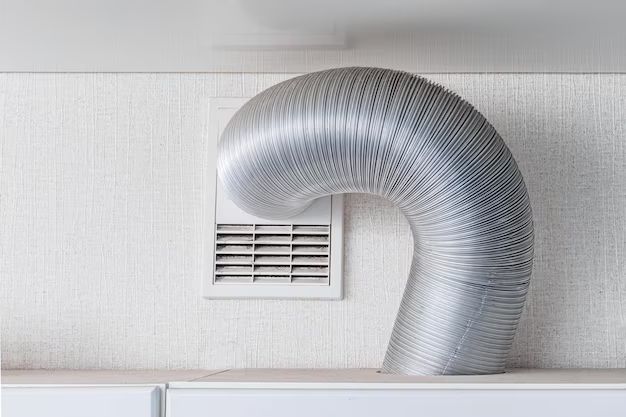When installing a gas dryer, proper ventilation is extremely important for safety and efficiency. The type of venting you need depends on your dryer model and configuration. Here’s a comprehensive look at gas dryer venting requirements to help you choose the right system.
Page Contents
Dryer Vent Basic Components
A basic dryer vent system is composed of the following parts:
- Vent hood – Fits over the dryer’s exhaust outlet to direct airflow.
- Vent duct – Smooth-walled pipe that connects the dryer to the outdoors.
- Elbows – curved vent pieces to route duct around corners.
- Clamps – Secure vent pipe connections.
- Vent cap – Hood with damper that seals vent outlet on exterior of home.
Proper installation requires connecting these components to create an unobstructed airflow path to efficiently carry moisture and lint outside.
Type of Venting: Rigid Metal Duct
For gas dryers, a rigid metal vent duct is required. Flexible plastic or foil ducts cannot be used due to the increased fire risk from the heated exhaust gases. The rigid metal pipes are less prone to kinks or crushing that could lead to blockages.
The most commonly used rigid metal vent ducts are:
- Galvanized steel: Sturdy and corrosion resistant, galvanized steel is the traditional standard rigid dryer duct type.
- Stainless steel: Offers increased lifespan and easier cleaning with high heat and corrosion resistance.
- Aluminum: Lightweight but still durable aluminum vent ducts are easy to install.
Rigid metal vent pipes approved for dryer use are 4 inches in diameter. Do not use smaller diameter ducts or longer runs than recommended, as this will increase resistance and reduce airflow.
Maximum Vent Length
The total developed length of the vent system from the dryer to the outdoors must not exceed the specified maximum vent length. This length depends on:
- Dryer Type – Electric vs gas dryers have different max vent lengths
- Vent Configuration – Exhaust setup with elbows affects allowable vent length
- Rigid Metal Duct Type – Different materials have specific length limits
Consult your owner’s manual for the maximum venting distance specific to your dryer model. As a general guideline for gas dryers:
| Vent Type | Max Length |
|---|---|
| Straight/smooth metal ducting | 35 feet |
| Rigid metal duct with 2 90° elbows | 25 feet |
| Rigid metal duct with 4 90° elbows | 15 feet |
For every 90 degree elbow, subtract 5 feet from the total allowed vent length. Avoid extra turns or bends wherever possible.
Venting Routes and Termination
In addition to length, the route and termination point of the dryer venting system must also follow code guidelines:
- Use the shortest, straightest duct path outdoors. Avoid extra turns or bends.
- Maintain a slope towards outdoors for any horizontal runs.
- Do not terminate vent in enclosed spaces like attics, crawl spaces, porches or garages.
- The vent must terminate on the exterior of the home, not inside soffits or overhangs.
- Install vent hood at least 12 inches above ground or any obstructions.
- The vent exit should be located away from doors, windows, AC units or other exterior openings.
Proper routing reduces resistance for best airflow. Following exterior termination guidelines prevents re-circulation of moist exhaust back into your home.
Vent Hood Dampers
The vent hood attachment on the exterior of your home will have an important damper component. This damper serves two key functions:
- Closes duct when dryer not in use – The damper flap closes off the vent opening when the dryer is not running. This prevents outdoor air, pests, or moisture from entering the ductwork and home.
- Opens when dryer turns on – As exhaust airflow starts when you run a load, the pressure will open the damper flap to allow the venting outside.
Make sure the vent damper is not stuck closed or blocked and can freely open when the dryer runs. Replace the entire vent hood if the damper operation is impaired.
Vent Maintenance
To ensure ongoing safe and effective dryer venting:
- Clean lint buildup from ducts annually using a dryer vent brush. Excess lint can impede airflow.
- Ensure duct connections are properly sealed with clamps. Check for leaks.
- Confirm the exterior damper opens and closes fully.
- Replace any damaged or rusted duct sections.
Proper dryer venting is critical for fire prevention and efficient operation. Follow the guidelines for your specific dryer and vent configuration so the system functions safely for many years.
Conclusion
Installing the right type of vent system is crucial when setting up a new gas dryer. Rigid metal ductwork within the maximum length for the model, properly routed and terminated, provides the safest and most effective exhausting. Careful planning, professional installation, and periodic maintenance gives you the best venting performance.
